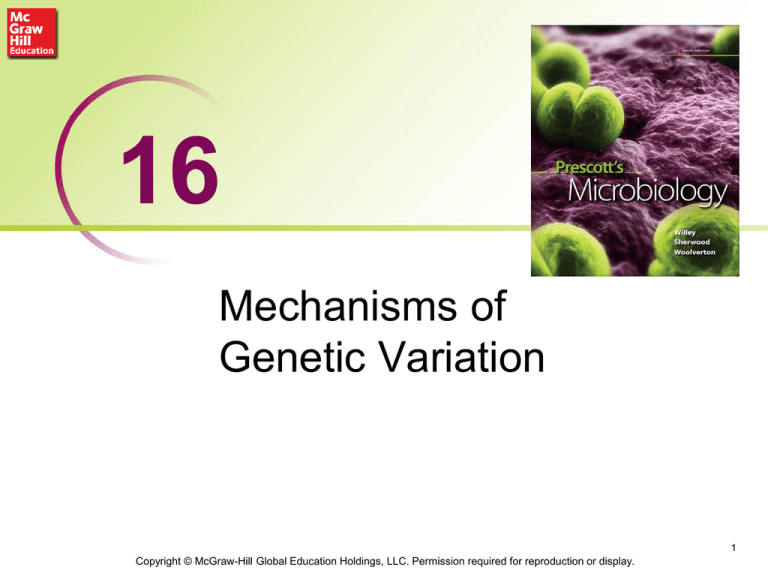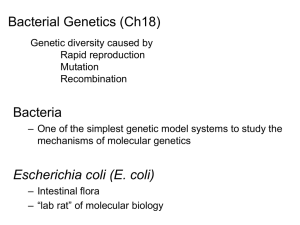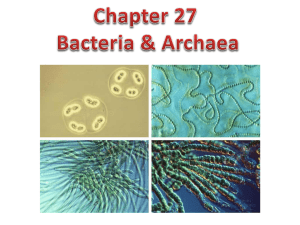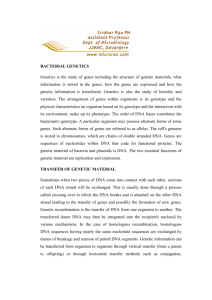
16
Mechanisms of
Genetic Variation
1
Copyright © McGraw-Hill Global Education Holdings, LLC. Permission required for reproduction or display.
Mutations: Their Chemical
Basis and Effects
• Stable, heritable changes in sequence of
bases in DNA
– point mutations most common
• from alteration of single pairs of nucleotide
• from the addition or deletion of nucleotide pairs
– larger mutations are less common
• insertions, deletions, inversions, duplication,
and translocations of nucleotide sequences
• Mutations can be spontaneous or induced
2
3
Effects of Mutations
• Wild type
– most prevalent form of gene
• Forward mutation
– wild type mutant form
• Reversion mutation
– mutant phenotype wild type phenotype
4
Detection and Isolation
of Mutants
• Mutations are generally rare
– one per 107 to 1011 cells
• Finding mutants requires sensitive detection
methods and/or methods to increase
frequency of mutations
5
Carcinogenicity
Testing
• Based on observation
that most carcinogens
are also mutagens
• Tests for mutagenicity
are used as screen for
carcinogenic potential
• e.g., Ames test
– reversion rate in
presence of suspected
carcinogen > reversion
rate in absence of
suspected carcinogen
– then, agent is a
mutagen, and may be
carcinogen
6
Creating Additional
Genetic Variability
• Mutations are subject to selective pressure
– each mutant form that survives becomes an
allele, an alternate form of a gene
• Recombination is the process in which one or
more nucleic acids are rearranged or
combined to produce a new nucleotide
sequence (recombinants)
7
Horizontal Gene Transfer (HGT)
in Bacteria and Archaea
• HGT differs from vertical gene transfer
– transfer of genes from one independent, mature
organism to another
• stable recombinant has characteristics of donor and
recipient
• Important in evolution of many species
– expansion of ecological niche, increased virulence
– occurs in the three mechanisms evolved by bacteria
to create recombinants
– genes can be transferred to the same or different
species
8
More about HGT Mechanisms
• Transfer of gene donor to recipient
• Exogenote
– DNA that is transferred to recipient
• Endogenote
– genome of recipient
• Merozygote
– recipient cell that is temporarily diploid as result of
transfer process
9
10
11
12
Bacterial Plasmids
• Small, autonomously replicating DNA molecules
– can exist independently from host chromosome
– can integrate reversibly into the host chromosome
(episomes)
• Conjugative plasmids (F plasmid) can transfer copies
of themselves to other bacteria during conjugation
13
Bacterial Plasmids - 2
• F factors contain the
information for
formation of sex pilus
– attach F+ cell to Fcell for DNA transfer
during bacterial
conjugation
• F factors have
insertion sequences
(IS)
– assists in plasmid
integration
14
Bacterial Conjugation
• J. Lederberg and E. Tatum demonstrated the
transfer of genes between bacteria that depends on
– direct cell to cell contact mediated by the F pilus
– unidirectional DNA transfer from donor to recipient
15
16
+
-
F x F Mating
• A copy of the F factor is transferred to the
recipient and does not integrate into the host
chromosome
• Donor genes usually not transferred
• F factor codes for sex pilus
– Type IV secretion system that makes contact
between cells that DNA moves across
• Plasmid is replicated by rolling circle method
17
18
19
20
HFr Conjugation
• Donor HFr cell has F factor integrated into its
chromosome
• Donor genes are transferred to recipient cell
• A complete copy of the F factor is usually not
transferred
• Gene transfer can be clockwise or
counterclockwise
21
22
F’ Conjugation
• Result when the F factor
incorrectly leaves the host
chromosome
• Some of the F factor is left
behind in the host
chromosome
• Some host genes have been
removed along with some of
the F factor
– these genes can be
transferred to a second host
cell by conjugation
23
24
25
Bacterial
Transformation
• F. Griffith demonstrated
transformation
• Uptake of naked DNA by a
competent cell followed by
incorporation of the DNA into
the recipient cell’s genome
26
27
28
Transduction
• The transfer of bacterial genes by viruses
• Viruses (bacteriophages) can carry out the lytic cycle
(host cell is destroyed) or viral DNA integrates into
the host genome (becoming a latent prophage)
29
Generalized
Transduction
• Any part of bacterial genome
can be transferred
• Occurs during lytic cycle of
virulent phage
• During viral assembly,
fragments of host DNA
mistakenly packaged into
phage head
– generalized transducing
particle
30
Specialized
Transduction
• Carried out only by temperate
phages that have established
lysogeny
• Only specific portion of
bacterial genome is
transferred
• Occurs when prophage is
incorrectly excised
31
Drug Resistance
• An increasing problem
– once resistance originates in a population it
can be transmitted to other bacteria
– a particular type of resistance mechanism is
not confirmed to a single class of drugs
• Microbes in abscesses or biofilms may be
growing slowly and not be susceptible
• Resistance mutants arise spontaneously and
are then selected
32
Drug Resistant “Superbug”
• A methicillin-resistant Staphylococcus aureus
(MRSA) that developed resistance to vancomycin
– this new vancomycin-resistant S. aureus (VRSA)
was also resistant to most other antibiotics
– isolated from foot ulcers on a diabetic patient
– Acquired from conjugation with vancomycin-resistant
enterococci (VRE) were isolated from same patient
• These drug resistant organisms are a serious threat
to human health
33
Mechanisms of Drug Resistance
• Prevent entrance of
drug
• Drug efflux (pump drug
out of cell)
• Inactivation of drug
– chemical modification
of drug by pathogen
• Modification of target
enzyme or organelle
• Use of alternative
pathways or increased
production of target
metabolite
34
The Origin and Transmission of
Drug Resistance
• Immunity genes
– resistance genes that exist in nature to protect
antibiotic producing microbes from their own
antibiotics
• Horizontal gene transfer
– transferred immunity genes from antibiotic
producers to non-producing microbes
35
The Origin and Transmission of
Drug Resistance
• Resistance genes can be found on
– bacterial chromosomes
– plasmids
– transposons
– integrons
• When found on mobile genetic elements they
can be freely exchanged between bacteria
36
Origin and Transmission…
• Chromosomal genes
– resistance from (rare)
spontaneous mutations
(usually result in a
change in the drug
target)
• R (resistance) plasmids
– can be transferred to
other cells by
conjugation,
transduction, and
transformation
– can carry multiple
resistance genes
37
Origin and Transmission…
• Composite transposons
– contain genes for antibiotic resistance – some
have multiple resistance genes
• can move rapidly between plasmids and
through a bacterial population
• Gene cassettes
– sets of resistance genes
– can exist as separate genetic elements
– can be part of transposon, integron, or
chromosome
38












